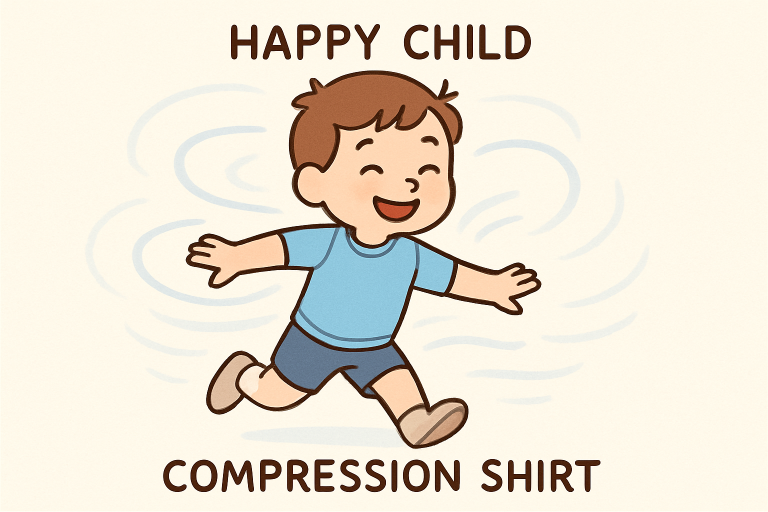What Are Compression Shirts for Kids?
Made from advanced moisture-wicking and breathable fabrics, modern compression shirts can help kids stay cool while feeling gentle “hugging” pressure around the chest and torso. These features not only support active play but may offer comfort to children who are sensitive to touch or have difficulty remaining calm in stimulating environments. For many families, these shirts blend seamlessly into routine, whether for sports, school, or simply feeling grounded during everyday adventures.
Compression shirts are close-fitting, stretchable garments that provide gentle, even pressure across the torso. Designed with kids’ unique comfort and movement needs in mind, these shirts can be worn under uniforms, as activewear, or incorporated into daily outfits. Increasingly, parents searching for practical solutions to support their children’s activity levels or sensory integration are turning toward compression shirts for kids to help them feel more secure and confident throughout the day.
Why Parents Choose Compression Shirts
Parents seek solutions for children’s well-being, comfort, and success—on and off the field. Compression shirts are easy to wear, versatile, and discreet under regular clothes, ideal for kids who don’t want to feel or look different. They offer non-medicated, non-restrictive benefits for active children or those with sensory processing challenges.
The variety of sizes, colors, and designs makes compression shirts accessible and appealing to a broad audience. Whether your child is an athlete, sensory seeker, or needs more comfort, these shirts provide versatile, discreet support, making them a staple in many children’s wardrobes.
Benefits for Sports and Everyday Play
Active children often face muscle fatigue, soreness, and skin irritation from prolonged physical exertion. Research indicates that the snug fit of compression wear can alleviate post-activity muscle soreness, expedite recovery, and ensure comfort during movement for growing bodies. For young athletes, these benefits can enhance endurance and reduce discomfort during and after practices or games. Compression shirts also aid in regulating body temperature, minimizing friction, and protecting delicate skin from chafing. They are particularly advantageous during extended events, training sessions, or when children rapidly switch between rest and activity. Furthermore, their moisture-wicking capabilities help keep children drier and cooler, reducing susceptibility to irritations caused by sweat and heat.
Support for Sensory Needs and Autism
Beyond athletics, compression shirts are gaining recognition for managing sensory processing disorders and ASD. Many children with these needs benefit from deep touch pressure—a calming feeling from gentle, even compression. Occupational therapists note that wearing a compression shirt can help children stay calm, focus better, and transition smoothly between activities. While helpful for daily regulation, they should be used with professional guidance and are not a standalone treatment. Combined with other therapies, compression shirts are an additional tool to improve children’s quality of life.

What the Research Says
Current research continues to illustrate the potential value of compression garments for children, especially those already engaged in regular physical activity or with unique sensory needs. For example, reports and clinical observations, as discussed by Parents.com, report noticeable improvements in self-regulation, reduced anxiety, and enhanced body awareness. However, each child is different, and what delivers impressive results for one may not have the same effect for another. Ongoing research and regular parent input remain vital to understanding how compression shirts can best complement children’s individual strengths and challenges.
Choosing the Right Compression Shirt
Finding the most effective compression shirt for your child is a process that benefits from considering several important criteria. These include:
- Material: Opt for airy, quick-dry fabrics designed for breathability and to wick away sweat.
- Fit: The shirt should be comfortably snug, never painfully tight or overly restrictive.
- Seams: Look for flat or seamless construction to avoid itching or skin irritation.
- Design: Choices are available in short-sleeve, long-sleeve, and tank styles, making it easy to select according to your child’s environment and preferences.
Involving your child in the selection process often leads to greater buy-in and comfort, especially for those with sensory preferences or sensitivities.
Tips for Safe and Comfortable Use
- Watch for any signs of discomfort, skin marks, or overheating, and adjust wear time accordingly.
- Avoid using compression shirts as replacements for medical treatment or prescribed therapy.
- Start with short increments of wear and increase duration gradually as tolerated and desired.
- If your child has underlying medical conditions, consult your healthcare provider or an occupational therapist before introducing any new compression gear.
Care and Maintenance Suggestions
Proper care is essential to ensure comfort, hygiene, and longevity for compression shirts. Wash shirts on a gentle cycle using cold water and mild detergents. Air drying is recommended to preserve fabric elasticity. Avoid using bleach and fabric softeners, which damage synthetic fibers and diminish the shirt’s effectiveness. Regularly check for signs of wear, such as fraying seams or thinning material, and replace shirts when necessary to maintain adequate support and safety.
Conclusion
Compression shirts are fast becoming a trusted staple for families with active and sensory-sensitive children. They offer a discreet, comfortable solution for muscle support and sensory management, and can be a meaningful part of helping kids succeed on the field, in the classroom, and beyond. While not a cure-all, compression shirts offer real benefits when chosen carefully and used appropriately. As awareness grows and options expand, parents have more resources than ever to foster thriving, comfortable kids in every aspect of their lives.
The Editorial Team at Healthcare Business Today is made up of experienced healthcare writers and editors, led by managing editor Daniel Casciato, who has over 25 years of experience in healthcare journalism. Since 1998, our team has delivered trusted, high-quality health and wellness content across numerous platforms.
Disclaimer: The content on this site is for general informational purposes only and is not intended as medical, legal, or financial advice. No content published here should be construed as a substitute for professional advice, diagnosis, or treatment. Always consult with a qualified healthcare or legal professional regarding your specific needs.
See our full disclaimer for more details.







